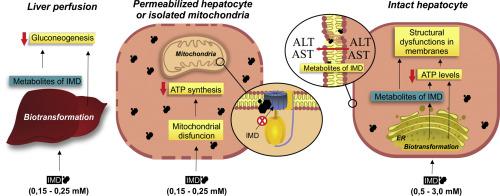当前位置:
X-MOL 学术
›
Pestic. Biochem. Phys.
›
论文详情
Our official English website, www.x-mol.net, welcomes your
feedback! (Note: you will need to create a separate account there.)
Enhanced cytotoxicity of imidacloprid by biotransformation in isolated hepatocytes and perfused rat liver
Pesticide Biochemistry and Physiology ( IF 4.2 ) Pub Date : 2020-03-01 , DOI: 10.1016/j.pestbp.2020.01.011 Paulo F.V. Bizerra , Anilda R.J.S. Guimarães , Camila A. Miranda , Rodrigo P. Constantin , Karina S. Utsunomiya , Eduardo H. Gilglioni , Jorgete Constantin , Emy L. Ishii-Iwamoto , Marcos A. Maioli , Fábio E. Mingatto
Pesticide Biochemistry and Physiology ( IF 4.2 ) Pub Date : 2020-03-01 , DOI: 10.1016/j.pestbp.2020.01.011 Paulo F.V. Bizerra , Anilda R.J.S. Guimarães , Camila A. Miranda , Rodrigo P. Constantin , Karina S. Utsunomiya , Eduardo H. Gilglioni , Jorgete Constantin , Emy L. Ishii-Iwamoto , Marcos A. Maioli , Fábio E. Mingatto

|
Imidacloprid (IMD) is a neonicotinoid insecticide widely used in crops, pets, and on farm animals for pest control, which can cause hepatotoxicity in animals and humans. In a previous study using isolated rat liver mitochondria, we observed that IMD inhibited the activity of FoF1-ATP synthase. The aim of this study was to evaluate the effects of IMD on rat isolated hepatocytes and perfused rat liver, besides the influence of its biotransformation on the toxicological potential. For the latter goal, rats were pretreated with dexamethasone or phenobarbital, two classical cytochrome P-450 stimulators, before hepatocytes isolation or liver perfusion. IMD (150 and 200 μM) reduced state 3 mitochondrial respiration in digitonin-permeabilized cells that were energized with glutamate plus malate but did not dissipate the mitochondrial membrane potential. In intact (non-permeabilized) hepatocytes, the intracellular ATP concentration and cell viability were reduced when high IMD concentrations were used (1.5-3.0 mM), and only in cells isolated from dexamethasone-pretreated rats, revealing that IMD biotransformation increases its toxicity and that IMD itself affects isolated mitochondria or mitochondria in permeabilized hepatocytes in concentrations that do not affect mitochondrial function in intact hepatocytes. Coherently, in the prefused liver, IMD (150 and 250 μM) inhibited gluconeogenesis from alanine, but without affecting oxygen consumption and urea production, indicating that such effect was not of mitochondrial origin. The gluconeogenesis inhibition was incomplete and occurred only when the rats were pretreated with phenobarbital, signs that IMD biotransformation was involved in the observed effect. Our findings reveal that changes in hepatic energy metabolism may be acutely implicated in the hepatotoxicity of IMD only when animals and humans are exposed to high levels of this compound, and that IMD metabolites seem to be the main cause for its toxicity.
中文翻译:

通过生物转化在分离的肝细胞和灌注的大鼠肝脏中增强吡虫啉的细胞毒性
吡虫啉 (IMD) 是一种新烟碱类杀虫剂,广泛用于农作物、宠物和农场动物以控制害虫,可导致动物和人类肝毒性。在先前使用分离的大鼠肝线粒体的研究中,我们观察到 IMD 抑制了 FoF1-ATP 合酶的活性。本研究的目的是评估 IMD 对大鼠分离肝细胞和灌注大鼠肝脏的影响,以及其生物转化对毒理学潜力的影响。对于后一个目标,在肝细胞分离或肝脏灌注之前,用地塞米松或苯巴比妥(两种经典的细胞色素 P-450 刺激剂)对大鼠进行预处理。IMD(150 和 200 μM)降低了用谷氨酸加苹果酸激活但不消散线粒体膜电位的毛地黄皂苷透化细胞中的状态 3 线粒体呼吸。在完整(非透化)肝细胞中,当使用高 IMD 浓度(1.5-3.0 mM)时,细胞内 ATP 浓度和细胞活力降低,并且仅在从地塞米松预处理的大鼠中分离的细胞中,表明 IMD 生物转化增加了其毒性和IMD 本身以不影响完整肝细胞线粒体功能的浓度影响分离的线粒体或透化肝细胞中的线粒体。一致地,在预融合肝脏中,IMD(150 和 250 μM)抑制了丙氨酸的糖异生,但不影响耗氧量和尿素产生,表明这种作用不是线粒体来源的。糖异生抑制不完全,仅在大鼠用苯巴比妥预处理时发生,有迹象表明 IMD 生物转化参与了观察到的效果。我们的研究结果表明,只有当动物和人类暴露于高水平的 IMD 化合物时,肝脏能量代谢的变化可能与 IMD 的肝毒性密切相关,并且 IMD 代谢物似乎是其毒性的主要原因。
更新日期:2020-03-01
中文翻译:

通过生物转化在分离的肝细胞和灌注的大鼠肝脏中增强吡虫啉的细胞毒性
吡虫啉 (IMD) 是一种新烟碱类杀虫剂,广泛用于农作物、宠物和农场动物以控制害虫,可导致动物和人类肝毒性。在先前使用分离的大鼠肝线粒体的研究中,我们观察到 IMD 抑制了 FoF1-ATP 合酶的活性。本研究的目的是评估 IMD 对大鼠分离肝细胞和灌注大鼠肝脏的影响,以及其生物转化对毒理学潜力的影响。对于后一个目标,在肝细胞分离或肝脏灌注之前,用地塞米松或苯巴比妥(两种经典的细胞色素 P-450 刺激剂)对大鼠进行预处理。IMD(150 和 200 μM)降低了用谷氨酸加苹果酸激活但不消散线粒体膜电位的毛地黄皂苷透化细胞中的状态 3 线粒体呼吸。在完整(非透化)肝细胞中,当使用高 IMD 浓度(1.5-3.0 mM)时,细胞内 ATP 浓度和细胞活力降低,并且仅在从地塞米松预处理的大鼠中分离的细胞中,表明 IMD 生物转化增加了其毒性和IMD 本身以不影响完整肝细胞线粒体功能的浓度影响分离的线粒体或透化肝细胞中的线粒体。一致地,在预融合肝脏中,IMD(150 和 250 μM)抑制了丙氨酸的糖异生,但不影响耗氧量和尿素产生,表明这种作用不是线粒体来源的。糖异生抑制不完全,仅在大鼠用苯巴比妥预处理时发生,有迹象表明 IMD 生物转化参与了观察到的效果。我们的研究结果表明,只有当动物和人类暴露于高水平的 IMD 化合物时,肝脏能量代谢的变化可能与 IMD 的肝毒性密切相关,并且 IMD 代谢物似乎是其毒性的主要原因。











































 京公网安备 11010802027423号
京公网安备 11010802027423号